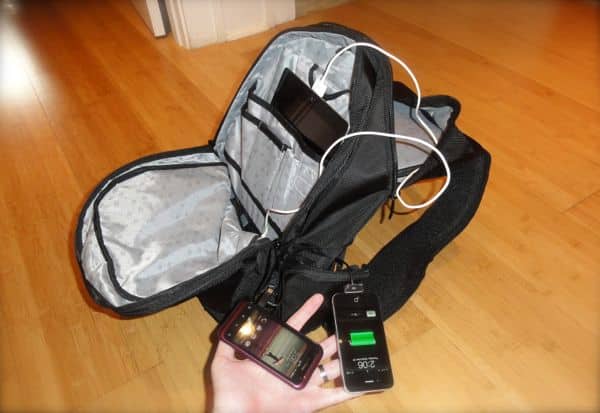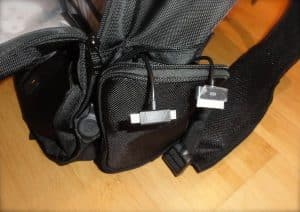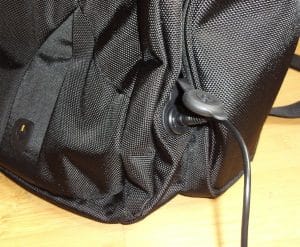
On the inside, though, the Powerbag has a secret weapon: a battery that charges up to four gadgets at once, including smartphones, tablets, iPods, you name it.
The compact, rechargeable lithium polymer battery comes hidden in a little zippered compartment in the bottom of the $169 backpack. (Messenger-bag and rolling-briefcase versions of the Powerbag are also available, with prices ranging from $139 to $249.)
About the size of a deck of cards, the battery comes with a USB port for charging, say, an iPad or an Android tablet; just plug the USB end of your tablet’s charging cable into the Powerbag’s battery, and you’ve got juice.
Also connected to the battery is a pair of power cords that snake into a small, zippered pocket on the side of the backpack.
Wired to the end of one of those cables is Apple’s 30-pin iPod connector, good for charging an iPod (natch), the iPod Touch, or an iPhone.
On the end of the second cable, you’ll find two plugs: a Micro USB connector, which will charge most recent Android smartphones, and a Mini USB plug for older cell phones and other compatible gadgets. (Click here for pictures and more info about Micro and Mini USB plugs.)

An iPod charging cable and powered Micro USB and Mini USB ports live in a side pocket, while a powered USB plug sits in the main compartment.
So, say you’re out on the town with the Powerbag and the battery indicator on your new HTC Status starts turns bright red. Just put your phone in the Powerbag’s side pocket, connect one of the two power cords to your smartphone’s microUSB port, and press the power button on the front of the backpack to start charging.
Pressing the power button also lights up the Powerbag’s own battery-life gauge, which is sewn into the fabric and invisible until it glows. Neat.
OK, so that’s how the Powerbag charges your gadgets, but how do you charge the Powerbag? Easy: just connect the included (and surprisingly light) AC adapter to a small, inconspicuous plug on the Powerbag’s outside shell, then plug the cord into a wall outlet.
Once connected to a power outlet, the Powerbag will first charge any gadgets that happen to be connected to the battery; after your various gadgets are fully charged, or if the Powerbag’s built-in battery isn’t connected to any smartphones, tablets, or other gear, the battery will start charging itself.
How does the battery perform? Pretty well, at least during my tests. I took the Powerbag with me on a day-long trip into Manhattan, and I connected my power-hungry Sprint Overdrive 4G portable hotspot—which usually only lasts for an hour or so on its own battery—to the backpack.
All day and late into the afternoon, the Powerbag-assisted Overdrive kept purring away. Later in the afternoon, with the Powerbag’s battery still going strong, I decided to give it the acid test: using the already red-hot Overdrive for streaming a movie over Netflix.
Only after connecting my MacBook Air to the Overdrive’s via Wi-Fi and watching “The Living Daylights” a couple of times did the Powerbag’s battery begin to wind down. Impressive.
As for the backpack itself … well, it’s sturdy, comfortable, and reasonably light (about two-and-a-half pounds, according to my scale, and that includes both the battery and the AC adapter).
The backpack has three roomy zippered compartments, including one with a zipper on the side for a laptop. The main compartment has several little pockets for odds and ends, including the tablet-sized pocket that I mentioned earlier.
The Powerbag’s battery is concealed in a small zippered pouch, with its power cables well concealed within the backpack’s lining—and indeed, a casual observer would probably never spot the Powerbag’s killer feature.
Bottom line: It may not win any awards for style, but the Powerbag is tops when it comes to keeping your gadgets charged, especially while you’re traveling.
Note: I’ll be returning the Powerbag to the company once I’m finished reviewing it.



